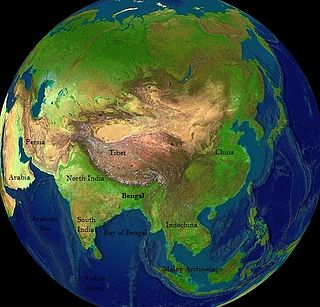Related Research Articles

Bengal or endonym Bangla is a historical geographical, ethnolinguistic and cultural term referring to a region in the eastern part of the Indian subcontinent at the apex of the Bay of Bengal. The region of Bengal proper is divided between modern-day sovereign nation of Bangladesh and the Indian state of West Bengal.

The Partition of India in 1947 was the change of political borders and the division of other assets that accompanied the dissolution of the British Raj in the Indian subcontinent and the creation of two independent dominions in South Asia: India and Pakistan. The Dominion of India is today the Republic of India, and the Dominion of Pakistan—which at the time comprised two regions lying on either side of India—is now the Islamic Republic of Pakistan and the People's Republic of Bangladesh. The partition was outlined in the Indian Independence Act 1947. The change of political borders notably included the division of two provinces of British India, Bengal and Punjab. The majority Muslim districts in these provinces were awarded to Pakistan and the majority non-Muslim to India. The other assets that were divided included the British Indian Army, the Royal Indian Navy, the Royal Indian Air Force, the Indian Civil Service, the railways, and the central treasury. Provisions for self-governing independent Pakistan and India legally came into existence at midnight on 14 and 15 August 1947 respectively.

Sir Khawaja Nazimuddin was a Pakistani politician and statesman who served as the second governor-general of Pakistan from 1948 to 1951, and later as the second prime minister of Pakistan from 1951 to 1953.

Huseyn Shaheed Suhrawardy was a Pakistani Bengali barrister and politician. In Bangladesh, Suhrawardy is remembered as a pioneer of Bengali civil rights movements, later turned into Bangladesh independence movement, and the mentor of Bangladesh's founding leader Sheikh Mujibur Rahman. He is also remembered for his performance as the Minister for Civil Supply during the Bengal famine of 1943. In India, he is seen as a controversial figure; directly responsible for the 1946 Calcutta Killings, for which he is often referred as the "Butcher of Bengal" in West Bengal.
South Asian literature refers to the literature that is composed by authors in the Indian subcontinent and its diaspora. It has an extensive history with some of the earliest known pieces of literature. South Asia has many different languages that have been spoken due to its size and how long people have been inhabiting it. This has caused the region to be the most linguistically diverse region in the planet, and as well as having four language families, hundreds of languages and thousands of dialects. Many modern pieces of South Asian literature are written in English for a global audience. Many of the ancient texts of the subcontinent have been lost due to the inability to preserve verbally transmitted literature. South Asia has many significant authors that shaped the postcolonial period and response to the British establishment in the subcontinent. Modern South Asian literature has a deep focus on independence from Britain, mainly expressed in prose, this literature commonly discusses the partition of India and how different South Asian nations, religions, and cultures interact with each other. Countries to which South Asian literature's writers are linked include India, Pakistan, Bangladesh, Sri Lanka and Nepal. Works from Bhutan, Myanmar, Tibet, and the Maldives are sometimes also included.

The history of Bengal is intertwined with the history of the broader Indian subcontinent and the surrounding regions of South Asia and Southeast Asia. It includes modern-day Bangladesh and the Indian states of West Bengal, Tripura and Assam's Karimganj district, located in the eastern part of the Indian subcontinent, at the apex of the Bay of Bengal and dominated by the fertile Ganges delta. The region was known to the ancient Greeks and Romans as Gangaridai, a powerful kingdom whose war elephant forces led the withdrawal of Alexander the Great from India. Some historians have identified Gangaridai with other parts of India. The Ganges and the Brahmaputra rivers act as a geographic marker of the region, but also connects the region to the broader Indian subcontinent. Bengal, at times, has played an important role in the history of the Indian subcontinent.

The first Partition of Bengal (1905) was a territorial reorganization of the Bengal Presidency implemented by the authorities of the British Raj. The reorganization separated the largely Muslim eastern areas from the largely Hindu western areas. Announced on 16 July 1905 by Lord Curzon, then Viceroy of India, and implemented West Bengal for Hindus and East Bengal for Muslims, it was undone a mere six years later. The nationalists saw the partition as a challenge to Indian nationalism and as a deliberate attempt to divide the Bengal Presidency on religious grounds, with a Muslim majority in the east and a Hindu majority in the west. The Hindus of West Bengal complained that the division would make them a minority in a province that would incorporate the province of Bihar and Orissa. Hindus were outraged at what they saw as a "divide and rule" policy, even though Curzon stressed it would produce administrative efficiency. The partition animated the Muslims to form their own national organization along communal lines. To appease Bengali sentiment, Bengal was reunited by King George V in 1911, in response to the Swadeshi movement's riots in protest against the policy.

The Partition of Bengal in 1947, also known as the Second Partition of Bengal, part of the Partition of India, divided the British Indian Bengal Province along the Radcliffe Line between the Dominion of India and the Dominion of Pakistan. The Bengali Hindu-majority West Bengal became a state of India, and the Bengali Muslim-majority East Bengal became a province of Pakistan.
East Bengali Refugees are people who left East Bengal following the Partition of Bengal, which was part of the Independence of India and Pakistan in 1947. An overwhelming majority of these refugees and immigrants were Bengali Hindus. During the Bangladesh liberation war with West Pakistan, an estimated ten million people of East Pakistan fled the country and took refuge in India particularly in the Indian states of West Bengal and Indian North East region, especially Tripura and Assam.

Bhadralok is Bengali for the new class of 'gentlefolk' who arose during British rule in India in the Bengal region in the eastern part of the Indian subcontinent.
West Dinajpur district was a district of the state of West Bengal from 1947 to 1992. At India's independence, the former Dinajpur district of undivided Bengal was partitioned along religious lines, and West Dinajpur became one of the 14 districts of West Bengal. The other part of the district continues as Dinajpur district of Bangladesh.

Bengali Hindus are an ethnoreligious population who make up the majority in the Indian states of West Bengal, Tripura, Andaman and Nicobar Islands, Jharkhand, and Assam's Barak Valley region. In Bangladesh, they form the largest minority. They are adherents of Hinduism and are native to the Bengal region in the eastern part of the Indian subcontinent. Comprising about one-third of the global Bengali population, they are the second-largest ethnic group among Hindus after Hindustani Hindus. Bengali Hindus speak Bengali, which belongs to the Indo-Aryan language family and adhere to Shaktism or Vaishnavism of their native religion Hinduism with some regional deities. There are significant numbers of Bengali-speaking Hindus in different Indian states. According to the census in 1881, 12.81 per cent of Bengali Hindus belonged to the three upper castes while the rest belonged to the Shudra and Dalit castes.
Jehangir Kabir was an Indian Bengali politician and trade union leader.
Bangladeshis in India are members of the Bangladesh diaspora who currently reside in India. The mass migration into India since Bangladesh independence has led to the creation of anti-foreigner movements, instances of mass violence and political tension between Bangladesh and India, but it has also created measurable economic benefits for both nations.
Sarah Frances Deborah Ansari is a British professor of history at Royal Holloway, University of London. She is a specialist in the recent history of South Asia, and particularly Pakistan and the partition of India.

Bengal is a region in South Asia, politically split between Bangladesh and India. Due to its long history and complicated political divisions, various names have been used to refer to the region and its subsections. The name Bangla is used by both Bangladesh and West Bengal in international contexts. In the Bengali language, the two Bengals each use a different term to refer to the nominally identified nation: Bānglā and Baṅga

Pather Dabi is a Bengali novel written by Sarat Chandra Chattopadhyay. It was first published as a novel in 1926, after having been initially serialized in the journal Bangabani. The book is set in British-occupied India.
David Anthony Washbrook was a British historian and author who studied modern India with a specific focus on the socio-political and economic conditions of South India between the 18th and 20th centuries. He was the director of the Centre for Indian Studies and a member of the Faculty of Oriental Studies at the University of Oxford and later a research professor and fellow of South Asian history at Trinity College, Cambridge.

Sekhar Bandyopadhyay is an Indian historian and a Fellow of the Royal Society Te Apārangi. Bandyopadhyay is known for his research on the Dalit caste of Bengal.
The Kolkata Partition Museum is an initiative dedicated to documenting the Partition of India from the Bengal perspective. Dissimilar to the Punjabi context, the Bengal province had been divided twice: once in 1905, and then in 1947. The aftermath of the second partition, as recorded by many historians, unfolded distinctly in postcolonial Bengal vis-à-vis Punjab. Not only was the impact long-drawn and can be witnessed even 75 years after the Partition, its affect can also be seen in the neighbouring states of Bengal and the rest of the country owing to refugee resettlements spread out to as far away states such as Maharashtra and Chhattisgarh. The idea behind the Kolkata Partition Museum is to preserve and present the vanishing memories of partition, to emphasise both the "rupture and continuities between West Bengal and Bangladesh – in terms of language and literature, food, fabric, and the performing arts – and to encourage collaboration between them." The museum aims "to do so by involving public participation in its programs and gearing all its activities in a way that makes it more accessible and interesting to the public at large."
References
- 1 2 3 "Professor Joya Chatterji FBA". Faculty of History. University of Cambridge. Retrieved 10 September 2018.
- 1 2 3 4 5 "Professor Joya Chatterji". Equality and Diversity. University of Cambridge: Faculty of History. Retrieved 10 September 2018.
- ↑ "Modern Asian Studies". Cambridge UP. Retrieved 10 September 2018.
- ↑ "Catalogue record for thesis". Copac . Retrieved 10 September 2018.
- ↑ "Professor Joya Chatterji". British Academy. Retrieved 10 September 2018.
- ↑ Creamer, Ella (15 February 2024). "Guardian writer and Observer critic longlisted for inaugural Women's prize for nonfiction". The Guardian. Retrieved 4 March 2024.
- ↑ Gelt, Jessica (20 April 2024). "L.A. Times Book Prize winners named in a ceremony filled with support for USC valedictorian Asna Tabassum". Los Angeles Times. Retrieved 22 April 2024.
- ↑ "Who we are: Dr Joya Chatterji". Bangla Stories. LSE / Runnymede Trust. Retrieved 10 September 2018.